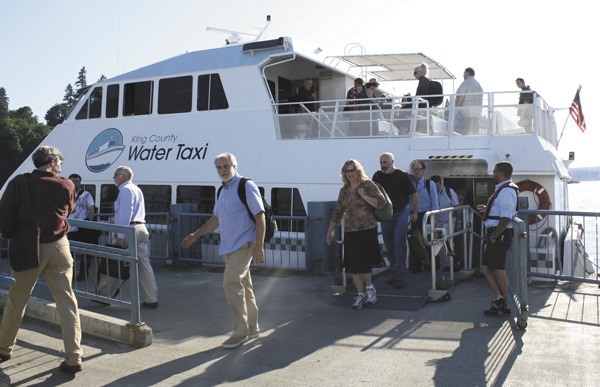Vashon’s water taxi continues to see an uptick in the number of passengers, resulting in more at-capacity sailings and presumably more riders left behind on the dock, according to the director of King County’s marine division.
In the first six months of this year, the pedestrian-only boat — which takes passengers into downtown Seattle — had 96 at-capacity sailings, meaning all of its 150 seats were full, said Scott Davis, the division’s director. That’s nearly double the number from the first six months a year ago, when the route experienced 57 full boats.
All told, it had 130 full boats in 2011 and 78 in 2010.
Because of the route’s growing demand, King County officials are working to increase capacity on the Melissa Ann, the 77-foot catamaran that serves the Vashon-Seattle route. Capacity is limited to 150 passengers, even though it has room for more, due to U.S. Coast Guard safety regulations that require larger crews and other measures when a boat goes beyond that number.
Officials had hoped to have met all the requirements to increase the capacity to 172 passengers at the beginning of this year. But the marine division’s staff is small, Davis said, and, in part because of post-9/11 security rules, the process is “fairly detailed.”
Davis said he expects the marine division, a part of the county’s Department of Transportation, will be able to increase capacity by the end of August.
“It’s taken us longer than we had hoped,” he added. “There’s no single reason for that. … I would not blame the regulator (the Coast Guard) at all. We’re a fairly small staff doing a lot of different things.”
Ridership on the boat, which zips to Seattle in about 22 minutes, has increased steadily since King County took over the pedestrian-only route from Washington State Ferries in September 2009. The route carried just under 111,000 passengers in 2009, Davis said. Ridership grew to 153,600 in 2010; last year, it climbed to 167,600. So far this year, Davis said, ridership has been higher every month over the same period a year ago, with the exception of January, when a snowstorm kept many commuters home.
“I’d like to think it’s because of good service, reliable service, on-time service,” he said. “We haven’t really changed the schedule.”
The at-capacity sailings, however, usually leave commuters on the dock. Davis said crew members try to determine how many people are left behind when the boat fills to its 150-person capacity, but it’s not always easy for them to count — since some people turn around quickly when they realize the boat is full. What’s more, he said, not every at-capacity sailing means people are left behind. Earlier this week, at least two sailings left the dock with exactly 150 people and no one left behind, he said.
However, he added, he knows people get left behind each month; in June, crew members counted 164 people.
Ferry officials don’t like seeing passengers left behind, he said, but, at the same time, the route’s growing popularity “has been very encouraging.”
“To use an asset and use it to its capacity is a good thing,” he said.
Meanwhile, the ferry district — once slated to grow significantly — continues to lack a sustainable budget, Davis said. Shortly after the county took over the ferry district, it lost much of its financial base due to a financial crisis that hit Metro Transit; the taxes slated to support the ferry district were instead diverted to Metro.
The ferry district, which also operates a water taxi between West Seattle and downtown Seattle, is now funded by fares and a much smaller tax base. But that only covers about 40 percent of its operating costs, Davis said, with the remaining 60 percent coming from a reserve account that will likely last until the end of the next biennium, or late 2014. But even that is uncertain, Davis said, noting several issues are up in the air.
“There are too many unknowns,” he said.
The ferry district, however, continues to move forward on plans to build two new water taxis, funded in large part by federal grants that are already in hand. The boats would replace the two catamarans it currently uses, both of which are leased. Staff is currently putting together a request for qualifications, which Davis hopes to release soon. The county could have contracts in place to build the first of the new boats in six to nine months, he said.
If the district owns its own small fleet, that could make the system more secure, he added. “Having assets of your own speaks to your longevity,” he said.



